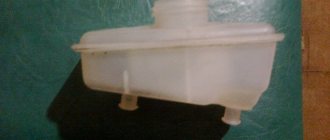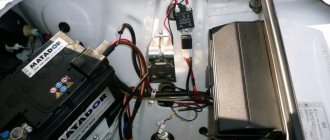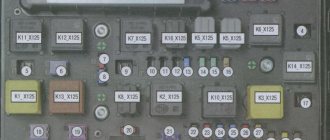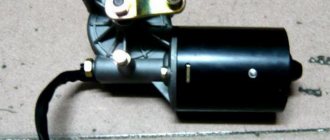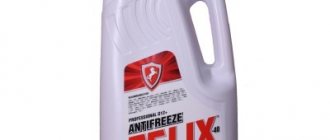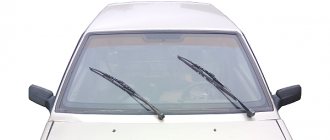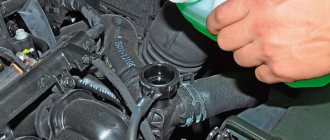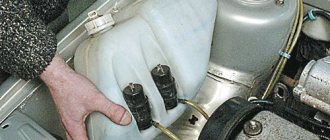What types of glass washer fluids are there?
All glass cleaning products can be divided according to several classification criteria.
Applicability:
- summer;
- winter (designed to work in conditions of negative temperatures).
By manufacturing method:
- ready-made compounds;
- liquid concentrates (diluted with boiled or distilled water in certain proportions);
- concentrates in tablets (added to water or prepared liquid to enhance the cleaning effect).
By chemical composition:
- simple liquids with a set of fragrances and surfactants (summer);
- isopropyl;
- ethyl;
- methyl;
- with the addition of ethylene glycol.
Types of windshield wipers for cars
Any car wash contains alcohol and auxiliary components: dyes, fragrances, solvents and surfactants that wash away remaining fats from the glass.
Types of windshield wipers for cars
The main component of any glass cleaner is alcohol of one of three types:
- Ethyl is not harmful to health, but it is unprofitable to produce technical fluids from it. Ethanol is subject to excise taxes like alcoholic beverages. In addition, when using such a washer, the car interior will smell of alcoholic beverages.
- Isopropyl alcohol is most often used in windshield cleaning fluids. It is hazardous to health, but has a sharp, unpleasant odor, which excludes its ingestion or undetectable vapor poisoning.
- Methyl alcohol freezes at the lowest temperatures and has almost no odor, but it is poisonous even if the vapors are inhaled. A small dose of the substance leads to blindness or death. Methanol-based liquids are prohibited for sale in Russia, but it can be found in fake washer fluids, which are sold second-hand on the highway at a low price.
Summer car wash differs from winter only in the percentage of alcohol. There are also windshield wipers for every season. They are a concentrate that needs to be diluted with distilled water in different proportions depending on the outside temperature.
All types of glass cleaners, even if they are practically odorless, emit toxic substances. Therefore, when using them, it is necessary to ventilate the interior of the car and try not to use the washer in traffic jams or in a parking lot.
Summer wash
Often drivers, in order not to spend money on special liquids, use ordinary water in the summer. Such savings can be costly for the car owner. Regardless of the season, small particles of dust, oils and fats settle on car windows. They are not washed off completely and are smeared with water, leaving streaks. Invisible during the day, at night they can form glare on the glass, greatly reducing visibility.
Summer car washer
Summer car wash contains solvents and surfactants that clean car windows from greasy film, insects and sticky pollen.
Winter anti-freeze
Winter windshield wiper fluid for cars contains from 15 to 75% alcohol. The higher its percentage, the lower the washer fluid freezes at lower temperatures.
Winter windshield wiper fluid for cars
Ethylene glycol is often added to the windshield washer composition, which slows down the evaporation of alcohol from the glass and prevents the formation of a crust of ice on it.
What is antifreeze?
Antifreeze, according to the standard, is a liquid that consists of an antifreeze concentrate, and according to the rules this should be alcohol (safe - we emphasize). The highest quality alcohol is ethyl alcohol, but it is not profitable to make anti-freeze for a car based on it, since ethyl alcohol itself is very expensive, even though it is diluted in concentrate. Methyl alcohol is cheap and odorless, but it is toxic and harmful to health, so it is prohibited from using it to create anti-freeze. But isopropyl alcohol, in turn, has a very sharp and well-defined odor, it is quite cheap, which makes it beneficial to use it for preparing an anti-freeze concentrate.
Anti-freeze is sold everywhere: in car dealerships, hypermarkets and supermarkets, as well as on the road. But we would like to draw your attention to the fact that it is best to buy anti-freeze in a reputable store and in no case from your own hands, since there is a high probability of purchasing a concentrate consisting of chemically hazardous substances that can cause harm not only to your car, but also to you. Vse-Sekrety.ru also advises not to skimp on antifreeze, but to buy concentrate from a more or less well-known manufacturer.
What types of anti-freeze are there? There are different types and packaging of anti-freeze products on sale. Well-known brands sell anti-freeze in special containers, while little-known brands usually sell them in plastic bottles (these are usually used to sell water). When choosing an anti-freeze solution, pay attention to what temperature the concentrate will withstand. Please note that there are two types of anti-freeze: ready-made and concentrate (which must be diluted with water in appropriate proportions). In addition, anti-freeze products come with or without fragrance - this is purely for everyone.
Inexpensive options for windshield wipers for cars
Rating of quality windshield cleaning products that can be purchased cheaply:
- "Clean mile" Can be used in cold weather down to -25 degrees, quickly cleans glass of grease and dirt and dissolves ice crust.
- The Taimyr washer does not freeze at temperatures down to -30, washes without leaving streaks, and is suitable for use in both winter and summer. The liquid has a sweet candy aroma.
- Ice Drive is a harmless product that can be used in frosts down to -30; it easily cleans glass and quickly dissolves ice.
Ice Drive
Although budget washers are inferior in quality to more expensive products, they also perform their function and do not harm the cleaning system.
How to drain water from the washer reservoir without removing
It is often not necessary to remove the reservoir; some procedures are carried out with the element installed, including draining the washer fluid.
What is anti-freeze made of and what are its properties?
Manufacturers of budget liquids use isopropyl alcohol, which has a pungent odor. Therefore, fragrances are usually added to such formulations. Antifreeze liquid can also be produced from aircraft deicer, which contains propylene glycol and surfactants. The antifreeze works very simply: when it comes into contact with frozen water, it removes it and prevents refreezing.
Important: methanol-based windshield washer fluids are prohibited in Russia. They are dangerous to human health and their sale is illegal.
Which liquids should be used and at what temperatures?
It’s good if you fill in the antifreeze before frost sets in. After all, even in autumn, the temperature often drops to zero at night, and the water in the tank can freeze. Depending on the value to which the thermometer drops in your band, choose a composition with a suitable value. For example, in Central Russia, the most popular non-freezing liquid for cars is that it can withstand down to -30 °C. For southern regions, a composition with a value of up to -15 °C is suitable, for northern regions - up to -50 °C.
Important: the temperature limit declared by the manufacturer shows at what temperature the liquid crystallizes. It doesn't freeze, but turns into mush, but you still won't be able to spray it.
Which composition should I take – ready-made or concentrated?
You can buy ready-made anti-freeze. She has an affordable price. It is sold in three- or five-liter canisters, mixed with water in the required proportions. However, if you want to save money, it is more profitable to take a concentrated composition. You can prepare a mixture suitable for operating conditions. For example, if in late autumn and early winter the temperature does not drop below -10 ° C, dilute the concentrate in a ratio of 1:2. When the thermometer drops lower, you can pour in a more concentrated composition - 1:1 or 1:0.5.
How to understand that the composition is of high quality?
Buy only branded liquids. You should not trust nameless canisters with a crooked label and unreadable information about the manufacturer. For example, formulations from the Hi-Gear and LIQUI MOLY brands have earned the trust of motorists. They are safe for human health, retain their properties at the stated temperatures, and do not harm the paintwork and plastic parts of the car.
Russian products
FENOM Clear glass FN127 (-20C)
This product is optimal for vehicle owners living in regions where winters are not too severe - the temperature will not drop below 20 degrees below zero. The composition has excellent frost-resistant qualities in its price range. The formula is well thought out, it thoroughly cleans the glass, thereby ensuring excellent visibility regardless of weather conditions.
Using this composition, it is possible to easily rid any glass surface of contaminants typical of winter road conditions. This anti-freeze agent can also be used to wipe headlights - after using it, not the slightest streaks or stains will remain. Wiper blades and any plastic elements will be reliably protected from the effects of abrasive compounds, which are often used to treat road surfaces in the cold season. The composition does not contain harmful substances, so the negative impact on humans and the environment will be minimized.
Advantages:
- Provides the driver with excellent visibility regardless of environmental conditions;
- Protects plastic and rubber products;
- Anti-freeze can be used to wipe headlights;
- There are no substances that can cause harm to human health or the environment.
Flaws:
- Not suitable for regions with harsh winters.
FENOM Clear glass FN127 (-20C)
Net mile (-25C)
It is produced by the domestic enterprise Tosol-Sintez on the basis of absolute isopropyl alcohol. In order to fight off the alcohol smell, the manufacturer uses special flavoring additives, dyes and special detergents. The formula is unique, thanks to it the antifreeze can easily remove any dirt from the surface of the glass, and it is as gentle as possible on windshield wiper blades. The product effectively removes snow from glass, including snow mixed with ice, removes mechanical contaminants such as sand, oil products, and copes excellently with any organic and mineral substances.
How to choose summer washer fluid
Summer washer differs in properties and composition from winter washer; with the onset of warm weather, it is necessary to drain the “anti-freeze” from the barrel and fill in summer washer. Winter liquid does not freeze at subzero temperatures and ensures that windows are cleaned from dirt and snow.
The summer washer does not contain chemicals responsible for the liquid state of the windshield wiper; its main task is to clean the windshield and rear window from dust, dirt, midges and small debris.
Today at the car market and store you can find a large selection of summer washer for every taste and budget, and a car owner who will take care of his car will buy liquid and will not pour water into the tank, not only from the tap, but also distilled.
When choosing a liquid, pay attention to some features:
- Concentration - summer liquid is sold in two versions - concentrate and ready-made liquid, which can be immediately poured into the car's tank. It is more economical to buy a concentrated composition, they last a long time and you can dilute the concentrate in the required proportion. Manufacturers indicate on the canisters the recommended amount of liquid and distilled water to obtain the washer.
- Composition - summer windshield washers are based on alcohols, ethyl, methyl and isopropyl. How well the glass dirt is washed off will depend on the type of alcohol contained in the liquid. The presence of surfactants indicates chemicals in the composition that are added to enhance the washing properties, remove grease, dirt, organic compounds, etc. Fragrances are needed to neutralize the sharp and unpleasant odor that contains alcohol and surfactants.
- To avoid buying a counterfeit, pay attention to the packaging and label ; the canister should not be wrinkled or scratched; on factory packaging, the label is glued evenly and corresponds to the name of the product; check that the threads on the lid have not been torn off, and that the concentrate itself is a light transparent color.
FOLK METHODS
Summer washer fluids are better than water at cleaning the windshield from midges and not leaving greasy stains that impair visibility. However, more often (of course, in the warm season) drivers make do with tap water, to which they add dishwashing liquid or special tablets containing active substances. But if you pour just about anything into the tank, you can “clog” the injectors. So more experienced and at the same time thrifty car enthusiasts prefer to pre-boil water. Or freeze it and pour it into the tank after defrosting. There are many folk ways to clean glass: some claim that dirt can be easily removed with ammonia, others argue that there is nothing better than a small amount of vodka in the tank. In general, it depends on the taste and color.
What colors are non-freezing liquids?
Most often, you can see antifreeze liquid on sale in two colors: blue and green. By analogy with antifreeze, in which color markings indicate the range of operating temperatures, many motorists think that the color of the liquid corresponds to a similar gradation. But this does not correspond to reality.
Why is the anti-freeze blue? Because this is exactly the dye the manufacturer added to their product. In addition, the non-freezing liquid contains:
- distilled water;
- isopropanol or ethanol;
- additives;
- fragrance.
A solution of alcohol in distilled water is the basis of the product. Thanks to the presence of isopropanol, the windshield washer will not freeze at sub-zero temperatures. Special additives are needed to improve the protective and cleaning properties of anti-freeze. Fragrances and flavorings should mask the pungent odor of alcohol, making the aroma more or less pleasant.
The dye is needed to distinguish the liquid from other automotive products. It does not affect the properties of the antifreeze in any way - it can be anything: yellow, pink, purple. The temperature regime of the non-freezing liquid is indicated separately on the packaging and depends on the ratio of water and alcohol, and not on the color of the dye.
SPARE PARTS STORE "AUTOMAG"
We continue on to the Automag spare parts store. This outlet has the friendliest staff. They not only explained to us the intricacies of proper “washing” of glasses, but even opened all the bottles so that we could choose the scent.
We considered the smell of liquid in a 5-liter canister for 135 rubles to be the most gentle. It didn’t take long to persuade the seller - the young man poured in the liquid and gallantly refused the money. It's nice that there are still people ready to help.
Our rating: excellent
Reasons to drain the washer fluid
Reasons for merging the washer fluid:
- The washer fluid on Vesta could freeze, causing the front and rear nozzles to stop working, as well as similar elements on the headlights if the driver installed them himself.;
- Poor quality liquid is poured;
- The washer fluid has been flooded for a long time and needs to be replaced.
These are the main reasons for replacing the washer fluid.
Draining liquid without dismantling
If the washer fluid is not frozen, it can be drained through the nozzles. It is enough to activate the pump naturally from inside the car and wait until the liquid stops flowing.
The motor should not run for more than 20-30 seconds without stopping, as it may overheat and fail.
If the driver forgot to fill in the anti-freeze, and it got sharply cold outside, then you can’t do without preliminary defrosting.
Defrosting the washer
Basic ways to defrost liquid:
- Move the car to a heated parking lot overnight.
- Turn on the engine and let it warm up the engine compartment.
- Order a liquid defrosting service at the car wash.
- Add a little alcohol if the reservoir is not full.
- Pour in the liquid that is used to defrost locks.
- Use a hair dryer.
If none of the described options can be accomplished, then you need to dismantle the element of the washer system and take it home.
How to change windshield washer fluid in a car
So, you have purchased anti-freeze windshield washer fluid, and you need to pour it into the reservoir. This procedure is not complicated, and you do not need to go to a service station - you can do the draining and filling yourself.
If you have never done this before, remember: the washer reservoir is located under the hood of the car (look for it on the left hand side in the headlight area). It is a small translucent/white container with a capacity of up to 3.5 liters with a blue, cyan, black or yellow lid, which can depict a windshield with a spraying washer.
You have to pour anti-freeze into it, but first you should check whether there is liquid in it, and if there is, then drain it.
How to drain liquid from the tank
Replacing water or fluid in the washer reservoir in the warm season is simple: water or weak anti-freeze can be completely used up by operating the steering column lever. The pump will blow all the liquid out of the system and reservoir. But this method is good if the tank is minimally filled: there is no need to put heavy loads on the washer pump electric motor!
If the tank is full (up to 3.5 liters in the tank + 1.5 liters in the line system), the liquid should be drained forcibly. There are several options for forced draining:
- You can blow it out of the system and empty the tank with an air compressor (the pump tube is connected to the windshield washer system, and the compressed air is turned on).
- You can drain the liquid through the windshield washer hose, which is disconnected from the nozzle and lowered into a drain container. After this, the windshield washer motor is turned on, and liquid under pressure is pumped out of the tank.
- You can unscrew the washer motor and drain the liquid through the resulting hole (but only if access to the motor is convenient).
If access to the hoses and washer motor is difficult (on some brands of cars this is really difficult), you can pump out the liquid from the reservoir using the simplest method - a rubber bulb with an elongated spout or a large syringe with a tube. Then all that remains is to expel the remaining fluid from the lines and injectors, using the steering column lever.
How to fill liquid
After the water or old windshield washer fluid has been drained, you can begin to fill in the new anti-freeze agent. It's simple: you need to remove the cap from the bottle and slowly pour the required amount of liquid into the neck of the tank. For convenience, you can use a large watering can.
When pouring, try not to splash the liquid past - there are electrical wiring and headlights nearby, which can short out if liquids get in. It is also important that the antifreeze does not spill onto the drive belt - this will worsen its technical characteristics.
In the same way, you can add windshield washer fluid when it is used up, or pour hot water into the anti-freeze tank if it freezes in the tank.
Important! After the liquid has been added, pump the windshield washer motor lever a little so that the anti-freeze agent flows into the system. It is also recommended to bleed the pipelines and nozzles before pouring liquid into an empty tank - it is necessary to prevent the formation of air pockets or old water.
Where is the glass washer reservoir located and where should I fill the washer fluid?
When we press the windshield washer lever, a small motor under the hood of our car drives an equally small pump.
As a result of this, the washer fluid from the reservoir is pumped into the washer nozzles - these are small protrusions with holes on the hood, directed towards the windshield. It is from there that, under the pressure created by the pump, the “washer” or, as it is also called, “anti-freeze” sprays. Let's find out what to do if the washer suddenly runs out. Where can we find the washer reservoir under the hood and where can we fill in the new anti-freeze agent? Firstly, during the autumn-winter-spring seasons, it is best to always have a supply of washer fluid in the trunk of 2-4 liters. It’s very unpleasant to find yourself in slushy weather without it and without the prospect of finding an auto shop within the next few kilometers. The second thing you need to know is that there are summer and winter washer options. The first is much cheaper, but freezes at low temperatures, while the second usually remains liquid down to -30 degrees. Therefore, it is necessary to choose one or another type of anti-freeze based on weather conditions. Remember that in some cases, frozen washer fluid (especially poor quality) can lead to destruction of the nozzles and their subsequent replacement.
So, where do we fill the antifreeze and where is the washer reservoir located in our car? The answer to this question is quite simple. In 99% of cases, the washer fluid reservoir is located under the hood. Therefore, the first thing to do is to pull the hood release lever (as a rule, it is located at the level of the left knee with a picture of an open hood on it). Then we go out, lift the hood lid and fix it using a special holder lever - you can also find it without any problems - usually it is inserted into the latch on the raised hood lid itself.
Next, we look for where the washer reservoir is located. Standing in front of the car, look at the left side of the engine compartment (relative to you); in almost all car models it is located immediately behind the headlight. The washer reservoir is a white or translucent tank with approximately 3.5-5 liters of anti-freeze.
And its lid will help us more specifically and accurately identify the washer reservoir. It is often blue or cyan in color, but can also be yellow or black. And it shows a windshield with a splashing washer. And we can make sure that this is the tank we need by assessing its contents - after all, since we have run out of glass washer, it should be empty (except in rare cases of clogged nozzles or a breakdown of the motor or pump of the washer system).
So, we have decided where to fill the washer fluid. You simply open the lid (usually it just snaps on, less often it unscrews) of the washer reservoir and the cap of the bottle with a new anti-freeze agent and begin to carefully pour in the contents of the bottle, trying not to splash the washer on other units and parts. If you suddenly splash something, then look to see if there are any wires coming off of it. If not, then everything is fine. It is also undesirable for the washer to get on the drive belt - this (however, in very rare cases) can worsen its performance.
Source
What you need to know when replacing a windshield washer
Maintaining the windshield washer system does not require much effort, but it is better to monitor and service it regularly to prevent blockages, traffic jams or ice from appearing in the winter. Important to remember:
- The system should be pumped periodically to remove air and water from it. This should be done before each new anti-freeze fill.
- There should always be a container with 3-4 liters of windshield washer fluid in the trunk to top it up if the reservoir is empty in the middle of the road.
- There is no need to fill the washer reservoir to the top. If the anti-freeze suddenly freezes, you should have room in the tank to add hot water, alcohol or anti-freeze concentrate to melt the ice.
- Antifreeze concentrate can be diluted if there is no serious frost or thaw outside, but the liquid and water should be mixed not in a tank, but in a separate container. This way you will protect the system from accidental incompatibility of components and will be able to control the concentration of the finished solution.
- If you accidentally poured low-quality anti-freeze into the tank, you should drain it completely. If you poured in a liquid with an inappropriate freezing point, you can simply add concentrate.
In conclusion, it should be noted that draining and filling windshield washer fluid in a car is a simple procedure that you can handle without outside help. In winter, replacing a windshield washer is more difficult, as there is a risk of freezing the liquid in the reservoir and pipelines, damaging the washer pump, or breaking the system's electric motor. Therefore, it is important to carry out all stages of work consistently and carefully.
Be sure to pay attention to the quality, characteristics, freezing point and seasonality of the windshield washer fluid, do not leave water in the windshield washer lines and do not let the system freeze in the cold.
OFFICIAL DEALER
The next destination is the “small homeland” of our “Focus”: the official dealership on Pavel Korchagin Street (Moscow). The polite girl greeting visitors asked what exactly brought us to the car dealership and directed us to the spare parts department.
Here, an equally polite employee, to our surprise, said that they do not have windshield washer fluids - neither summer nor winter. It's not the season yet. Opening the Focus owner's manual: "Use a mixture of windshield washer fluid and water to prevent freezing in cold weather and improve cleaning ability."
We were very surprised: the official dealer did not have everything necessary for the car owner to fulfill the company’s requirements. Let's see how it is with the washer in other places.
Our rating: two plus (plus for politeness)
Selecting windshield washer fluid
Before adding windshield washer fluid, it is necessary to select it. Preference should be given to one that does not freeze at a temperature of -25-30°C. Any car glass cleaner contains alcohol, water, various fragrances, etc.
Alcohol is needed to prevent water from freezing at sub-zero temperatures. It is worth noting that the alcohol in the washer fluid can also be different, namely:
- Methyl;
- Ethyl;
- Isopropyl.
The best solution is a washer solution containing ethyl alcohol.
, because it does not contain any unpleasant odor. This windshield washer fluid in a store can cost about 200-250 rubles for 5 liters. In second place is a product with the addition of isopropyl alcohol. It can emit a smell that manufacturers try to cover up with all sorts of flavorings.
However, often this smell can be felt even inside the car.
In last place is a liquid based on methyl alcohol, which, in fact, is generally prohibited for use due to its extreme toxicity. We have already found out where and how to fill the windshield washer fluid, now it’s time to find out how a low-quality glass washer fluid affects the human body.
Window cleaners based on methyl alcohol or any other prohibited substance can have a number of negative consequences for human health.
If all these symptoms arose after replacing the windshield washer fluid, then this is undoubtedly the only problem. We urgently need to replace it with a better one. To avoid such situations, it is strongly recommended that you first fill the reservoir with a minimum of liquid and check it for odors and the above symptoms. If there are none, then the tank must be filled to the required level.
Another piece of advice
To answer the question of where to fill the windshield washer fluid, you will need to buy detergent exclusively in specialized stores, since the likelihood of running into a fake at gas stations or, say, in a shopping center is very high.
Adviсe
It’s worth starting with the fact that under no circumstances should you replace windshield washer fluid with plain water. Of course, this is very economical since water is easily accessible and ubiquitous. In addition, you don’t need to go to the store and look for a product suitable for your specific car. However, there is a downside to this situation.
After replacing the windshield washer fluid with water, it is usually thought that before the onset of frost, he will definitely change the water back to a special windshield washer fluid. At the same time, the person does not think at all that during this time he will have a lot of things to do, and he will simply simply forget about such a seemingly trifle.
This whole situation will lead to the fact that sooner or later there will be frost outside the window and it will not be possible to simply drain the water from the tank. Now you need to look for a warm room and defrost the tank, which will lead to a loss of time. Therefore, to prevent this from happening, you should never replace this liquid with water.
Glass washer - which one to buy
Which antifreeze is better and how to choose the right product for the winter? First of all, do not buy auto chemicals “at the curb” - only at gas stations and in special stores. Today there are enough liquids from a variety of manufacturers that offer certified safe products. You can buy fakes or even poisonous compounds from your hands.
How to distinguish high-quality auto chemicals
:
- look at the label - it should contain detailed composition, as well as the purpose and method of use;
- shake the canister - foam should form on the surface, which indicates that the product contains a surfactant;
- look at the lid - branded anti-freeze products are sold in transparent or translucent containers with protection against leakage;
- Check the liquid - there should be no flakes, sediment or irregularities in it.
How much does a good anti-freeze cost? The average price for products ranges from 200-500 rubles per 5 liters. It depends on the volume of the canister, brand, minimum temperature and other factors. For example, Liqui Moly Antifreeze costs about 480-520 rubles. Concentrates that need to be diluted yourself may be more expensive. But even an expensive product is unlikely to cost more than 800-1,000 rubles.
Non-freezing liquid “Versta” 4l
High-quality windshield washer from . The liquid is effective at temperatures down to -30ºС. It is based on isopropyl alcohol. The product also contains special anti-corrosion additives. Has a pleasant smell.
Antifreeze does not contain toxic impurities. It is completely safe when used correctly. The product does not damage wipers, plastic parts, or paint, so it is suitable for all brands of cars.
Packaging volume – 4 liters.
Price – 130 rubles
Non-freezing liquid “Versta” 5l
The isopropanol-based product does not contain phosphates, ammonia and methanol. It is completely safe for health, as well as for the car - the liquid does not destroy paintwork, plastic, or rubber.
Anti-freeze will help cope with dirt, road reagents, and oil film. Thanks to special additives, the product protects against the adhesion of dirty drops. It leaves no streaks, making the glass transparent and clean.
Recommended temperature – up to -30ºС.
Container volume – 5 liters.
WHAT ABOUT THEM?
Most gas stations in Europe operate on a “help yourself” principle; you don’t often see gas station attendants and cleaners. In most cases, drivers refuel their cars without assistance. And, by the way, they wash it too.
At gas stations located along the highway, a container with detergent and a scraper are usually installed next to the pump - use it, no one charges money for it. After a long trip, the windshield is littered with traces of insects that even a good product cannot wash off. So such a service is extremely useful and in demand.
Why can't you pour water?
It would seem, why spend money on buying a special washer fluid in the summer if water flows from the tap, which does a good job of cleaning glass. The answer is simple, any water contains impurities and sediment, which over time is deposited on the walls of the barrel for the liquid to be washed, on the tubes and spray mechanisms.
After 3-5 years of using ordinary water in the washer, the system becomes unusable due to dense calcium deposits on the tubes and nozzles of the sprayer. When you first have problems with the windshield washer, you have to disassemble the entire system and look for the cause, since you cannot operate the car with faulty windshield wipers and a washer reservoir.
Water also contributes to the appearance of rust , and most of the elements in the car are made of metal. Rust forms on injectors, pump impellers, etc., therefore, prolonged contact with water is contraindicated in the car system. The metal will corrode and parts will need to be replaced.
The washer fluid contains substances for cleaning glass; tap water does not contain this; it is not able to cope with greasy or dried stains, as well as resin droplets and heavy dirt.
The best inexpensive antifreezes
Net mile (-20°C)
Rating: 4.6
A budget anti-freeze product of purely domestic production, providing adequate cleaning functions without claims to compete with the pillars of the market. It copes well with removing ice from glass, simultaneously getting rid of traces of dirt without streaks. Despite the rather modest production costs, the liquid contains a substance that prevents the composition from freezing in order to avoid destruction of the tank and the entire washer system as a whole. Instead, the antifreeze takes on a gel-like (viscous) consistency and has a low expansion coefficient.
The main problem of the Clean Mile is non-compliance with the specified temperature conditions. Instead of -20, anitfreeze can barely withstand -16 degrees Celsius, solidifying to the point where it is impossible to spray. Due to serious operational limitations, it would not be practical to use it in regions with severe winters.
Advantages
- low expansion coefficient and complete safety for the washer system;
- good cleaning abilities;
- low cost;
- gentle on plastic.
Flaws
- The actual pour point is 4 degrees higher than stated.
Rating of summer washer fluids
In order not to get confused when choosing a glass washer, read reviews about the product on the Internet; now there are many websites for automotive products and online stores where you can find not only the information you are interested in, but also choose an option for your car. We have compiled our own rating based on reviews on the Internet about summer glass liquid.
LIQUI MOLY is a German manufacturer of automotive products that produces effective and popular fluids. The volume of the concentrate is 250 ml, diluted with water in a ratio of 1 to 100, resulting in 25 liters of liquid. Removes grease and dirt from the windshield and rear glass without harming the rubber seals and paintwork of the car. It has three flavors: peach, lime, apple.
KERRY - available in a 270 ml bottle, without added flavors and fragrances, or with the scent of berries. It perfectly cleans grease and stubborn stains from glass; the bottle has a dispenser bottle for easy preparation of the solution. Diluted with water 1 to 100, you get 27 liters of washable liquid.
SONAX XSTREME - the manufacturer produces three types of liquid. Ready-made in a four-liter canister - no need to dilute with water, it is immediately poured into the tank, the liquid washes not only the glass, but also the mirrors, headlights and panels in the car, and is safe for the body. The concentrate in 250 and 500 ml bottles is diluted 1 to 100.
PINGO - liquid is sold in 1 liter bottles, with lemon, strawberry, apple aroma or odorless, diluted in a ratio of 1 to 10. Cleans the windshield from grease stains, organic deposits, debris and dirt, has no sediment, is safe for the car body and rubber elements.
When should you add anti-freeze?
It is best to fill the anti-freeze solution based on weather forecasts. As soon as subzero temperatures are expected at night, it is recommended to pour this antifreeze liquid into the washer barrel of your car. If autumn is delayed, then by November you can fill the substance, regardless of weather forecasts. At first, the weakest concentrate will work, since there will be no significant frosts, but closer to mid-November, you need to fill in a fairly strong concentrate that will withstand severe frosts.
How and where to pour antifreeze?
It's very easy to do. To do this, open the hood and find the neck of the glass washer reservoir. Usually it has a blue lid; it will display the windshield with wipers. Open it and fill it with anti-freeze. If the neck of the barrel is deep at the bottom, then use a watering can (not a gasoline one!). You can buy a regular kitchen watering can or make one from a cut-out bottle neck.
When pouring antifreeze, consider the volume of the barrel. As soon as the liquid reaches the level of the tube leading to the neck, the barrel is full. When the concentrate is poured in, close the lid tightly.
Close the hood and perform a test fluid supply. That's all. Good luck on the roads!
In autumn, winter and early spring, it is very important to keep your car windows clean; driving safety depends on it. While in summer they can be washed with plain water, in winter this method will not work due to low temperatures. Drivers use a special liquid to wash the windshield. This kind of anti-freeze for cars is sold in any specialized store, or you can make it yourself.
Typically, car enthusiasts in the store are guided by the price or freezing point of the liquid. Based on these two parameters, they make their choice.
You can distinguish a high-quality anti-freeze product by price. The more expensive the cost, the higher quality ingredients are in the composition. Don't skimp on antifreeze. A good product will effectively clean the windows of dirt, will not harden into an icy crust while driving, and will not cause harm to the driver and passengers.
It is more profitable to buy in plastic bottles of 3-5 liters. Then the cost of 1 liter is 10% cheaper compared to other packages. But it is in them that they most often sell diluted or poisonous liquid.
A quality product is immediately visible from the label. It should indicate:
- manufacturer's name and address;
- rules of application;
- Date of issue;
- compound.
On each label, manufacturers write the temperature at which the non-freezing liquid loses its properties. All information must be written in a clear font and easy to read.
Another important quality for washer fluid is the ease of pouring into the tank. Most products come in awkward containers, so the driver needs to keep a funnel in the car.
Frequently asked questions from car owners
How and where to add windshield washer water?
- In the cabin, open the hood handle
- Finally open and secure the hood
- Unscrew the large cap on the windshield wiper reservoir, the one without wires
- Pour liquid into the tank. Approximately five liters will fit in this canister
Different times of the year require different windshield wipers to clean glass. In winter, at low temperatures, it is recommended to fill in an antifreeze additive. It will protect the tank from freezing, and with it the parts of the windshield wiper system will not burst from temperature overloads. In summer, it is recommended to add a cleaning additive to the water. During this period, abundant sediment of exhaust gases, oils, and car paint care products accumulates on the glass.
Advice: for the best effect, you should first pour the additive into the tank, and only then ordinary water. This will allow the liquids to mix better.
How can you heat the windshield wiper reservoir in winter?
Option one: homemade
Materials: 1 meter of 8 mm copper tube, 2 meters of 8 mm wrapped hose, 2 reservoir cuffs and 4 clamps.
Heating installation technology: two holes for cuffs are drilled in the tank lid. A copper tube is already inserted into them, which must be given the reliefs of the tank in advance. At the exit, the tube should be in a horizontal position. The hoses are connected to the throttle body and thermostat.
Option two: in the form of a coil
Technology: the same copper tube as in the first option. But here it is given the shape of a coil using a soldering iron. The resulting coil is not attached, as usual, to the tank instead of a lid. It is soldered to a textolite plate. Afterwards, the homemade coil is installed in the tank as low as possible so as not to interfere with the liquid level sensor.
Holes for the thermal device are cut using a soldering iron. This way they turn out neat. Their diameter is 3 millimeters. The edges should be lubricated with sealant. The best fastening for the device is stainless steel screws. When installing, they should be heated with a soldering iron - this way they will be better fixed in the windshield washer reservoir.
Option three: ready
This is a ready-made heating system for the Geyser tank washer. Operating principle: as it passes through the coil, the temperature of the coolant begins to rise. Accordingly, the degree of liquid in the tank also increases.
Why does the anti-freeze freeze?
Antifreeze is so called because it remains liquid even at low temperatures. But already at -10-15º it can freeze, although the label stated that the product is effective at -25ºC.
The fact is that the crystallization temperature of a liquid directly depends on the alcohol content in it. The higher the proportion of isopropanol or ethanol, the more severe the frost the antifreeze will not freeze. If the alcohol content is only a quarter of the total volume, such a mixture will begin to freeze already at -15ºС. At a concentration of 75%, the liquid will retain its properties even at -35ºС.
Alcohols are volatile compounds that evaporate quickly. And the higher the proportion of alcohol, the more intense the evaporation. Therefore, if the anti-freeze agent was poured into the tank a long time ago and was not renewed for several months, the isopropanol will partially evaporate and the liquid will lose its properties. For this reason, it is important to stock up on a new portion of washer every season, rather than storing last year's supplies.
The same problem can arise if water or summer washer was not drained from the system before adding anti-freeze. The resulting mixture already has a lower alcohol content, which means the liquid will freeze at a higher temperature than indicated on the label.
What to do when the anti-freeze is frozen? If the liquid freezes right in the tank, you need to start the engine and wait until the car warms up well. Or drive the car to a warm garage. When the antifreeze melts, you need to drain it and replace it with another liquid that is designed for lower temperatures. The same applies to the case when the liquid freezes directly on the glass.
It is not recommended to dilute the composition with vodka or alcohol. The resulting mixture may damage the tank or pipes. It is better to find a proven liquid from a reliable manufacturer.
Why do you need an antifreeze?
Non-freezing liquid, or in common parlance - non-freezing liquid, is used as a means for washing the windshield in the cold season. That is, the anti-freeze agent is poured into the glass washer reservoir, instead of the usual concentrate that you use in the summer.
Probably, judging by the name, you have already guessed that antifreeze comes from the word “does not freeze.” Why do you need an antifreeze? And it is needed so that the liquid in the windshield washer reservoir does not freeze. If the liquid freezes, then you will not be able to wash the glass, and you can also destroy the washer barrel, since it is made of plastic, and if ice forms inside it, it can crack and become unusable.
How to make a summer wash with your own hands - what to avoid
And also, within the framework of this article I would like to tell you about solid concentrates. Usually they are tablets, or simply powders (for example, “Every day” from Lenta). Such concentrates do their job very poorly, and often also leave streaks, grains of undissolved particles, and cloudy smudges on the sides of the windshield.
We also have an article on how to make winter washer fluid (anti-freeze) - add our articles to bookmarks or share them on social networks so as not to lose them!
How to make antifreeze yourself?
It's quite simple. If you don’t want to spend extra money on an expensive anti-freeze, but don’t want to fill a cheap one made from chemicals, then you can prepare the anti-freeze yourself. In addition, this advice is also suitable for those who need to go on the road, but there are no anti-freeze supplies left in the garage. There are 3 methods for preparing anti-freeze, the highest quality anti-freeze is made from pure ethyl alcohol, a vodka-based anti-freeze is somewhat more profitable, and the most budget-friendly is an anti-freeze based on isopropyl alcohol. Please note that the higher the alcohol content, the more durable the anti-freeze will be in severe frosts.
- DIY anti-freeze option No. 1
Why is it important to fill the washer fluid and not water?
We also offer you to watch a video where the author clearly explains why in the summer you need to use a washer, and not water or a winter anti-freeze.
Sources
- https://topdetal.ru/stati/kak_vybrat_zhidkost_dlya_omyvaniya_stekol/
- https://avtoshark.com/article/ratings/autochemistry/omyvajka-dlya-mashiny/
- https://AutoClub174.ru/lada-drugoe/kak-slit-vodu-i-zalit-nezamerzajku.html
- https://www.vseinstrumenti.ru/avtogarazhnoe-oborudovanie/avtohimija/ochistiteli/stekla/nezamerzajka/
- https://shosse.ru/stati/chto-zalivat-v-bachok-omyvatelia-letom/
- https://FokSevmash.ru/elektronika/kuda-zalivat-stekloomyvayushchuyu-zhidkost.html
- https://www.driver-helper.ru/text/sovetiy/kak-zamenit-stekloomyvayushhuyu-zhidkost-v-bachke
- https://o-ladagranta.ru/kuda-zalivat-zhidkost-dlja-omyvanija-lobovogo/
- https://autoread.ru/soveti/kak-sdelat-letnyuyu-omyvajku-svoimi-rukami.html

